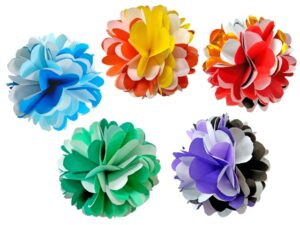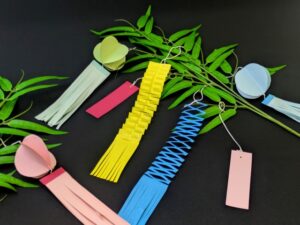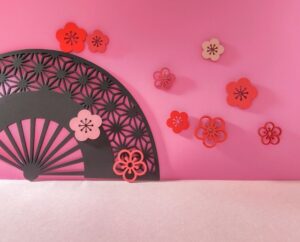In today’s world where LINE and email are mainstream, less than 15% of people send summer greeting cards. That’s precisely why the one card you send will make a special impression.
“What kind of message should I write?” “When is the right time to send it?” “What design will please the recipient?” We’ll solve all these questions.
From close friends to business partners, we’ll share how to create summer greeting cards that touch the hearts of recipients, along with ready-to-use text examples and design ideas.
Why not deepen bonds with important people through the special feeling created by the warmth of handwritten messages?
What are Summer Greeting Cards? Basic Information and Meaning
Summer greeting cards are traditional Japanese seasonal greetings sent during hot summer periods to show concern for the recipient’s health and report on one’s current situation. This custom has continued since the Edo period and is cherished in modern times as an important communication tool alongside New Year’s cards.
In today’s increasingly digital world, the warmth of handwriting and paper has gained special value.
Origins and History of Summer Greeting Cards
Summer greeting cards are a traditional Japanese seasonal greeting that has continued since the Edo period. Originally, they began as greetings to show concern for the health of people who had helped during the hot summer. When postcards became popular during the Meiji era, they became widely established as a convenient means of conveying feelings. During the post-war reconstruction period, they became beloved by many people as an important seasonal greeting alongside New Year’s cards.
Purpose and Role of Summer Greeting Cards
The main purpose of summer greeting cards is to show concern for the recipient’s health and report on one’s current situation.
They serve various roles such as conveying gratitude to those who have helped you, maintaining relationships that tend to become distant, and deepening trust in business relationships. Especially in today’s digital age, they can give recipients a special feeling through the warmth of handwriting and paper postcards.
The Value of Summer Greeting Cards in Modern Times
In modern times, LINE and email have become mainstream, and the number of people sending summer greeting cards has decreased to less than 15%. However, this is precisely why the warmth of “handwriting” and “paper” has gained even more value.
They leave a lasting impression on recipients and are increasingly used in business and private settings as an effective means of conveying special feelings and thoughtfulness.
How to Write Summer Greeting Cards and Etiquette
By mastering proper writing techniques and etiquette, you can send heartfelt summer greeting cards without being rude to recipients. It’s important to understand the basic structure and choose appropriate expressions according to your relationship with the recipient. It’s also effective to use both handwriting and printing, taking advantage of each method’s characteristics.
Basic Structure of Summer Greeting Cards
Summer greeting cards consist of four elements: greeting, main text, closing, and date.
Key Points for Greeting Text
The greeting text “Shochu omimai moushiagemasu” (Summer greetings) is most common. It’s proper etiquette to write this phrase larger than other text at the top of the postcard.
For business use, use “Shochu omimai moushiagemasu,” and for close relationships, use “Shochu omimai moushiagemasu” or “Shochu omimai itashimasu.”
How to Write Main Text and Closing
In the main text, start with words showing concern for the recipient’s health. For example, “How are you doing?” or “I trust you are in good health.”
Next, report your current situation and express gratitude. For the closing, end with words wishing for the recipient’s health, such as “Please take care of yourself” or “Please take good care of your health.”
Writing Etiquette and Precautions
Attention to Honorific Language and Word Usage
In summer greeting cards, it’s important to use honorific language appropriately according to your relationship with the recipient.
For superiors, use polite expressions like “How are you doing?” or “I trust you are in good health,” and for close friends, choose friendly expressions like “Are you doing well?” or “How have you been?”
Differences Between Handwriting and Printing
Handwritten summer greeting cards easily convey warmth and sincerity, giving recipients a special feeling. On the other hand, printed cards have readable text and are efficient when sending many cards.
The recommended approach is adding a handwritten note to printed text. This achieves both efficiency and warmth.
Common Writing Mistakes
A common mistake in summer greeting cards is using punctuation marks.
Not using punctuation marks in greeting cards is proper formal etiquette. Also, don’t use opening and closing formalities like “Haikei” and “Keigu.”
For dates, write “Reiwa ○nen Seika” (Reiwa ○ year, midsummer) without specific dates, which is generally standard.
Recommended Text Examples and Sample Collection for Summer Greeting Cards
By choosing appropriate text examples according to your relationship with the recipient and purpose, you can create more effective summer greeting cards. We’ll introduce text examples for various situations, from close friends to business use. Use these examples as reference to create your own personal message.
Text Examples for Close Friends
For close friends and family, use casual expressions to create a sense of familiarity.
“Summer greetings. Hot days continue every day, but how are you doing? Thanks to you, our whole family is doing well. Please take care not to get sick in this heat. Reiwa ○ year, midsummer”
Text Examples for Business and Business Partners
For business relationships, aim for more polite and formal expressions.
“Summer greetings. How are you doing? We deeply appreciate your continued special consideration. We look forward to your continued guidance and encouragement. We pray for your good health during this season. Reiwa ○ year, midsummer”
Text Examples for Expressing Gratitude and Apologies
When using it as a thank-you note, it’s effective to include specific episodes.
“Summer greetings. Thank you for taking time from your busy schedule the other day. Thanks to you, the ○○ matter is progressing smoothly. Hot days continue, but please take good care of your health. Reiwa ○ year, midsummer”
Reply Text Examples
When replying to received summer greeting cards, include feelings of gratitude.
“Summer greetings. Thank you for your thoughtful greetings. It’s wonderful to hear that you are also doing well. The hot weather seems to continue, but please take good care of your health. Reiwa ○ year, midsummer”
Design and Material Selection Points for Summer Greeting Cards
Design and material selection that influences the impression of summer greeting cards are important factors in whether recipients will be pleased.
By choosing seasonal designs and considering the recipient’s preferences, you can create summer greeting cards that truly touch their hearts.
Material texture and environmental considerations are also important selection criteria in modern times.
Design Examples That Create Seasonal Atmosphere
For summer-like designs, choose seasonal motifs such as sunflowers, morning glories, goldfish, or wind chimes. For colors, cool blues and greens, or vibrant yellows and oranges are effective. Landscape photos of seas, mountains, and fireworks festivals are also popular. Even simple designs can create impressive results with season-conscious color schemes.
Choosing Designs According to Recipients
It’s important to choose designs according to the recipient’s age, preferences, and relationship. Elderly people prefer traditional Japanese designs and calm colors. For business relationships, choose simple and elegant designs. For families with children, cute illustrations and bright colors are appreciated.
Postcard Materials and Characteristics
Appeal of Washi Paper and Premium Paper
Washi paper postcards have a good texture and luxurious feel. They have natural texture and warmth, creating a special feeling. While more expensive than regular postcards, they’re perfect for summer greetings to important people. The ink colors also appear beautifully when printed, resulting in high-quality finishes.
Environmentally Conscious Material Options
Recently, postcards using environmentally conscious recycled paper and FSC-certified paper have increased. These materials are suitable for summer greetings to environmentally conscious people and are effective for business use by companies that value social responsibility.
How to Create Original Custom Designs
You can create original designs using computer or smartphone apps. By utilizing free templates or using photos you’ve taken yourself, you can create unique summer greeting cards. Scanning hand-drawn illustrations and incorporating them also results in warm finishes.
When and Timing to Send Summer Greeting Cards
Knowing the appropriate timing to send summer greeting cards is essential for providing proper seasonal greetings without being rude to recipients. By choosing sending times that consider regional differences and recipient situations, your summer greeting cards will convey more thoughtfulness. It’s also important to properly understand the timing for switching to late summer greetings.
Optimal Timing for Sending Summer Greeting Cards
The period for sending summer greeting cards is from Shosho (around July 7) to the day before Risshu (around August 7). The most appropriate period is mid-July to early August. Sending during this period gives recipients appropriate seasonal feelings.
Mail them so they arrive by August 6 at the latest.
Differences in Sending Timing by Region and Recipient
Since heat begins at different times in different regions, it’s important to consider the region where the recipient lives.
Mid-July is common in Kanto, while late July is typical in Kansai. It’s also necessary to consider the recipient’s work and lifestyle to avoid busy periods.
Timing for Switching to Late Summer Greetings
After Risshu (around August 7), switch from summer greetings to late summer greetings. If you send after this period, use the greeting “Zansho omimai moushiagemasu” (Late summer greetings). Late summer greetings are generally sent until the end of August.
Business Applications of Summer Greeting Cards
In business settings, summer greeting cards become valuable tools for deepening relationships with customers. By practicing utilization methods that leverage company and store characteristics while maintaining proper etiquette, you can differentiate yourself from competitors. Let’s also learn effective utilization methods as direct mail.
Business and Store Summer Greeting Application Examples
Companies and stores can use summer greeting cards as a means to convey gratitude to customers. Beauty salons send them with thanks for customer visits and summer hair care advice, while real estate companies use them to maintain ongoing relationships with clients who have signed contracts.
Business Etiquette and Precautions
Business summer greeting cards should use designs incorporating company logos and brand colors. Aim for polite and formal expressions in text, and avoid putting sales messages at the forefront. It’s also important to handle personal information carefully and manage addresses appropriately.
Key Points for DM (Direct Mail) Utilization
When using summer greeting cards as DM, naturally incorporate introductions of seasonal products and services. For example, summer special sales or new product announcements. However, the key to success is avoiding excessive sales appeal and prioritizing consideration for recipients.
Tips for Creating Summer Greeting Cards That Please Recipients
To create summer greeting cards that truly please recipients, ingenuity beyond mere formal greetings is necessary.
By mastering consideration from the recipient’s perspective and how to write memorable messages, you can send summer greeting cards that make recipients feel warm.
Creating Memorable Messages
To write memorable messages, incorporating shared memories and experiences with the recipient is effective.
Including specific episodes like “We had such an enjoyable time at ○○ the other day” makes them more memorable. Also, mentioning the recipient’s hobbies and interests can create familiarity.
How to Convey Consideration According to Recipients
It’s important to choose considerate words according to the recipient’s situation.
For those with children, use “How are your children’s summer vacations?” For elderly people, use “Please take extra care of your health during this severe heat,” choosing expressions that empathize with the recipient’s position.
Effects of Adding Handwritten Notes
Simply adding a handwritten note to printed text greatly improves warmth and sincerity.
“It’s wonderful to see you doing well” or “Let’s meet again soon” – even short phrases can give recipients a special feeling. What matters more than beautiful handwriting is putting your heart into it.
Key Points for Easy-to-Reply Content
To make content easy for recipients to reply to, avoid question-format sentences and don’t create pressure.
Adding a phrase like “No reply necessary” can reduce the recipient’s burden. Also, reporting your own current situation makes it easier for recipients to share their news too.
Differences Between Summer Greeting Cards and Late Summer Greeting Cards
Summer greetings and late summer greetings are seasonal greetings that differ in sending time and greeting phrases.
Understanding proper usage allows you to convey appropriate seasonal feelings to recipients.
The switching timing at Risshu also represents Japanese culture that values seasonal awareness.
Definitions of Summer Greetings and Late Summer Greetings
Summer greetings are seasonal greetings sent from Shosho to the day before Risshu. Late summer greetings, on the other hand, are greeting cards sent from Risshu until the end of August.
Both have the same purpose of showing concern for recipients’ health, but they differ in seasonal feeling and expression methods.
Differences in Sending Time and Timing
Summer greetings are appropriate from around July 7 to August 6, while late summer greetings are from around August 7 to the end of August.
Properly understanding these periods allows you to give recipients appropriate seasonal feelings. The switching at Risshu is particularly important etiquette.
Differences in Text Examples and Etiquette
For greeting phrases, summer greetings use “Shochu omimai moushiagemasu,” while late summer greetings use “Zansho omimai moushiagemasu.”
In the main text, summer greetings use “Hot days continue,” while late summer greetings use “Hot days continue even after Risshu,” with different words expressing seasonal feelings.
Current Status and Future Trends of Summer Greeting Cards
In the modern era of advancing digitalization, the usage situation of summer greeting cards is changing, but this is precisely why new value is being discovered. Through initiatives suited to the times, such as environmental consideration and approaches to younger generations, traditional seasonal greetings are gaining modern appeal.
Usage Status and Challenges of Summer Greeting Cards
Currently, the number of people sending summer greeting cards has decreased to less than 15%, with particularly significant decline in usage among younger generations. They tend to be avoided for reasons such as “no one to send to,” “too troublesome,” and “digital tools are sufficient.” However, this situation conversely increases the rarity value of summer greeting cards.
Coexistence of Digitalization and Paper Postcards
Even as digitalization advances, paper postcards have unique value. Texture, visual impression, and durability cannot be replaced by digital means. In the future, more effective communication will be possible by using digital tools and paper postcards appropriately.
Future Trends and Notable Services
Recently, services that allow easy design creation on smartphones and handle printing and mailing have gained attention. New initiatives such as using environmentally conscious materials and digital integration utilizing QR codes are also increasing.
These services improve the convenience of summer greeting cards and are expected to increase users.
Approaches to Younger Generations
To convey the appeal of summer greeting cards to younger generations, integration with social media and providing Instagram-worthy designs are effective. Also, it’s important to emphasize the “special feeling of analog” that digital natives can appreciate and help them rediscover the value of handwriting and paper warmth.
Conclusion
The key points of this article are as follows:
- Summer greeting cards are seasonal greetings sent from mid-July to early August
- Basic structure consists of four elements: “greeting, main text, closing, date”
- Text examples and design selection according to relationship with recipients are important
- Adding handwritten notes creates warmth and special feelings
- Business use is effective for building trust relationships with customers
- Paper postcard value increases precisely because of the digital age
Summer greeting cards are wonderful communication tools that give form to feelings of caring for others. Why not deepen bonds with important people through proper etiquette and heartfelt messages?












Comments